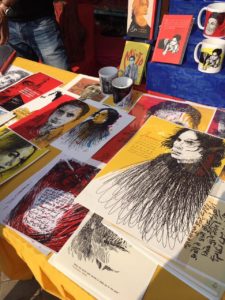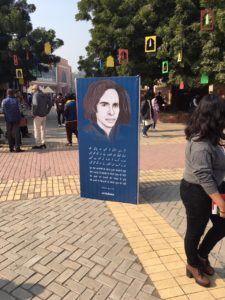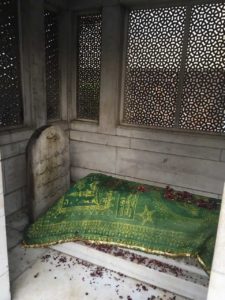In February 2018, I was at a musha‘ira, a poetic gathering, organized by the Delhi state government in a large park at the heart of Connaught Place, New Delhi. This park is, in many ways, the center of the city. Connaught Place was built as the premier shopping district for the British imperial capital, and it remains central to public life, the attractions of flânerie through its circular pillared corridors now only enhanced by the fact that two of the most heavily trafficked subway lines of the Delhi Metro intersect under the central park. The Delhi government, run by the Aam Aadmi Party, has made the park a site of cultural events, free and open to the public, like the musha‘ira that I, along with thousands of others, attended that evening.
About halfway through the musha‘ira, the poet Iqbal Ashar got up to recite a ghazal. He recited it in tarannum, singsong, prefacing the ghazal with a title. This, he said, is Achche dinon ka marsiya. The elegy of good days. Achche Din—or rather #achchedin, because it is very much a social media phenomenon—was the slogan of Narendra Modi’s election campaign in 2013-14. A marsiya is a song of elegy for the martyrdom of Hussain and his family and followers at Karbala, an event central to the devotional life of Shia Muslims, but with much wider ethical and religious resonances. Iqbal Ashar was signaling to the audience that he was bringing together political critique and theology. The fifth sh‘er,or couplet, of the ghazal did so in a manner that was powerful and unsettling, and made the gathered crowd cheer and clap with admiration and applause.
Munkir-e Karbala hue, dard meN mubtala hue
Hamko bhi ek Yazid ka daur dikha diya gaya
We became deniers of Karbala, we were embroiled in [an ordeal of] pain
We, too, were shown the age of a Yazid
In the center of the city, three miles from the Prime Minister’s official residence, a mile and a half from Parliament, a poet stood up and equated the reign of Narendra Modi with the age of Yazid—the archetypal tyrant of Islamic memory, the one who had members of the family of the Prophet and his followers brutally killed at the Battle of Karbala. The crowd roared its appreciation.
* * *
A documentary about resettlement in the wake of the Muzaffarnagar riots was screened in September 2018 in a small basement theatre in an elite neighborhood in South Delhi. The screening marked the fifth anniversary of the riots, which saw the mass displacement of Muslims in the Western Uttar Pradesh countryside, where they had hitherto lived peaceably with their Hindu Jat neighbors. One of the discussants commenting on the movie was Apoorvanand, a professor of Hindi at Delhi University and one of the most vocal critics of Hindutva politics writing and speaking in Hindi. In his comments, he moved from speaking about the testimonies of the riot survivors to speaking of the persistence of Urdu in India.
What they were saying was a kind of literature, it was poetry. They were speaking poetry (voh sha‘iri bol rahe the). The purpose of the violence—which was to snatch their humanity from them—remained unfulfilled . . . In India Muslims have given refuge (panah) to Urdu and for this we should be grateful to them, because Hindus have abandoned Urdu (Hinduon ne Urdu ka saath chhor diya hai).
Urdu and Hindi are virtually identical at the level of everyday speech—they share the same grammar and largely overlapping vocabularies. However, the scripts are radically different—Urdu written in a modified form of the Persian script, Hindi in Devnagari—as are the higher literary registers, vocabularies, tropes, and even affects invoked by the two languages. Even in an oral setting, like a musha‘ira or a kavi sammelan (assemblies where poets read their poetry to audiences), it is easy to distinguish “Urdu” from “Hindi.” And Urdu, since the partition of the subcontinent in 1947, has largely been identified with Muslims in India, and has systematically been marginalized. Apoorvanand’s comments mark a shift from thinking of Urdu as exclusively Muslim to thinking of Muslims as the custodians of a shared heritage that Hindus have forgotten, but have the potential to reclaim.

The musha‘ira at which Iqbal Ashar recited his ghazal was held in Old Delhi, in the grounds outside the Red Fort, until 2017. The move of the musha‘ira from Old Delhi—an area often identified as a Muslim ghetto—to the very heart of New Delhi is symbolic of the ways in which Urdu, especially Urdu poetry, has moved from the margin to a more central place in public discourse over the last few years. A big part of this can be attributed to the Rekhta Foundation, patronized by the industrialist Sanjiv Saraf, who is Hindu. In January 2013, the Rekhta website went online, and suddenly a whole textual and audiovisual archive of the Urdu literary tradition was available to anyone with a cheap smartphone. The 2018 Jashn-e Rekhta Festival, a three-day celebration of Urdu poetry and prose organized by the Rekhta Foundation, was visited by an estimated one hundred and sixty thousand people in a central location in Delhi.
Yet much of Urdu poetry remains undeniably Islamic in its referents, and conversations about Urdu poetry are often conversations about matters as central to the Islamic tradition as the Quran. In a talk widely viewed on YouTube, Ankit Gautam quotes the Quranic phrase kun faya kun and translates it for his audience to explain Jaun Elia’s famous sh‘er:

Hasil e kun hai yeh jahan e kharab
Yahi mumkin tha aisi ujlat men
This ruined world is the result of “Be”
Only this was possible in such haste
How do we understand the Islamicness of Urdu poetry and also the spread of Urdu poetry far beyond the bounds of exclusively Muslim identity? Images and themes from Karbala, for instance, can be found in the poetry of many of the young Urdu poets of Delhi, many of them with identifiably non-Muslim names. There is a doubleness to the public life of Urdu sha‘iri. It is simultaneously a universal discourse and an Islamic discourse. Even today, even in the most segregated of mushairas in Delhi, when poets walk into the space, they gesture with an adab rather than salam or namaste; an adab makes no necessary assumptions about the religious identity of the addressee.
At the same time, poets are very aware of sha‘iri’s connections to Sufism. When asked what sha‘iri is in an interview he was giving to a TV channel, the poet Azhar Iqbal said that poetry is connected to spirituality and to Sufism; it is a journey to meet one’s self. It is worth noting here that when Azhar speaks of the connection between poetry and Sufism, he does not speak of Sufism as esoteric practice, or as institutionally bounded, as we often imagine religion to be, but as an everyday mode of speaking of and speaking to the self. For many of the new young poets, Urdu poetry is exciting precisely because it gives them a language to explore their interiority, to express the complexities of the self. Ankit Gautam, for instance, reads the poetry of Jaun Eliya as an invitation to the examined life.
[W]e are all searching for ourselves. . . . Jaun . . . has found himself, and . . . no one has accepted the truth of themselves with such honesty. Jaun says:Apne andar hansta hoon main, aur bahut sharmata hoon
Khoon bhi thooka sach much thooka aur voh sab chalaki thiI laugh inside myself, and I am embarrassed
I spat blood, I really did, and it was all deceit
* * *
Urdu poetry, with its traditions of self-scrutiny and self-reflection, is a poetry of self-knowledge, and also a poetry of rebellion against social convention. The paradigmatic protagonist of the Urdu ghazal is Majnun, the madman who shuns society and wanders the desert, driven mad by his love for his unattainable beloved. Majnun, in Shahab Ahmed’s account, is a central figure in “the intellectual articulation, literary elaboration, and social proliferation of the ‘maddhab of love,’” a dominant strand of Sufi theology, ethics, and political thought in the “Balkans to Bengal complex.” The poets of Delhi understand Majnun as a figure of exploring the desert of the self, andarun ka sahra. Majnun is also a figure in sha‘iri of the shedding of all social convention, often with frenzied violence (vahshat).
The young poets of Delhi are programmers and salesmen, college students and consultants, teachers and workers for the Delhi Metro. They are respectable, enterprising, middle-class citizens of India. They have audiences of tens of thousands of people through live mushairas, and through YouTube, WhatsApp, and Facebook. What potentials does this moment of (re)discovering a mode of self-expression and self-articulation hold for public life? The figure of Majnun who abandons society in his frenzied wandering is in some ways the opposite of the ideal self of the Hindu nationalist imaginary, sincerely committed to the defense of sacred cows.
Most of the young poets I spent time with in Delhi are not necessarily political in the sense of talking about or being active in electoral politics. But they embody a certain vision of human freedom, unconstrained by the social conventions that increasingly have the force of law in contemporary India. In a time of religious polarization, they gather together without any concern for who is Hindu and who is Muslim. In a time when WhatsApp has led to lynchings and vitiated public discourse, it has also allowed poets to create online communities across cities and national borders. In a time when people have been lynched for the contents of their fridge, when the poets gather together, meat eaters and vegetarians eat at the same table, teetotalers and drinkers sit up together all night, and no judgments are passed. All that matters is the poetry. The young poets of Delhi embody the Ghalib sh’er:
Ham muvahhid hain hamara kesh hai tark-e rusum
Millaten jab mit gain ajza-e iman ho ga’in
We are monotheists, our practice is the renunciation of customs
When religions were erased, they became parts of faith
* * *

Ghalib is the most well-known of the classical Urdu poets of pre-colonial Delhi. His words and image have returned to prominence in Delhi in recent years in pop-art, in plays, and in memes, as part of the greater revival of Urdu sha‘iri. But in contrast to an earlier mode of understanding Ghalib as irreligious, there are now discourses that recognize Ghalib as Islamic. Chadars are now offered at Ghalib’s grave, as at the graves of Sufi saints; Iqbal Ahmed Khan, the head of the Delhi gharana of music (and disciple of the religious scholar Khwaja Hasan Sani Nizami) has publicly declared Ghalib to be a wali, a Muslim saint; and at least one major Shia scholar has publicly declared Ghalib to be Islamically meaningful. If Ghalib, the paradigmatic figure of the Urdu poet in Delhi, is being recognized as both “secular” and Islamic in contemporary India, at a moment of Urdu poetry’s revival in an age of Hindu majoritarianism, then what genealogy could we trace of the current moment and its political and ethical potentials?
All images are courtesy of the author.














Thank you for sharing.